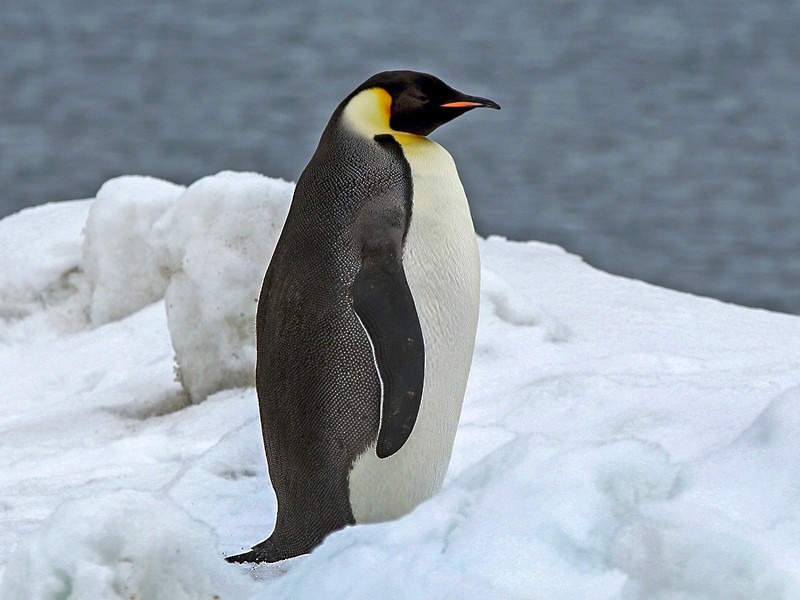The Majestic Emperor Penguin: A Comprehensive Exploration of the Antarctic Royalty

Introduction:
The Emperor Penguin (Aptenodytes forsteri) stands as a regal symbol of resilience and adaptability in the frigid and unforgiving landscapes of Antarctica. These remarkable birds, the largest of all penguin species, have captured the world’s imagination with their extraordinary behaviors, unique adaptations, and the challenges they overcome in their harsh environment. In this comprehensive exploration, we delve into every aspect of the Emperor Penguin’s life, from their physical characteristics and life cycle to their social dynamics and the conservation challenges they face in a changing world.
- Physical Characteristics: Adapting to the Antarctic Extremes
Emperor Penguins are characterized by their striking appearance, with a sleek black and white plumage that provides effective camouflage against the ice and sea. Standing at an impressive height of around 45 inches (115 centimeters), they are the largest of the 18 penguin species. Their robust bodies and streamlined shape enable them to navigate the water with remarkable agility, reaching depths of up to 1,850 feet (565 meters) in search of prey.
Notably, the Emperor Penguin’s wings are adapted into flippers, aiding in swift underwater movement. These flippers, combined with their rigid, torpedo-shaped bodies, allow them to travel great distances in search of food and navigate through the icy waters of the Southern Ocean.
- Life Cycle: The Epic Journey from Egg to Adulthood
The Emperor Penguin’s life cycle is an awe-inspiring saga of endurance and familial bonds. Their breeding cycle begins with the formation of vast colonies during the Antarctic winter, where thousands of penguins huddle together to shield themselves from the brutal cold. In June, the females lay a single egg before transferring it to the males, who incubate it on their feet for an astonishing 64 consecutive days.
Enduring the harshest weather conditions on Earth, the male penguins fast during this period, relying on their fat reserves to sustain them. Once the eggs hatch, the females return from their foraging trips to feed the chicks, initiating a delicate dance of parental care in the extreme conditions of the Antarctic.
- Social Dynamics: The Power of Colony Living
Emperor Penguins are renowned for their remarkable social dynamics, characterized by intricate communication, teamwork, and communal living. The colonies, where thousands of penguins congregate, serve as a crucial component of their survival strategy. The collective body heat generated by huddling helps them endure the extreme cold, and a carefully orchestrated rotation system allows each individual to take turns on the outer edge of the huddle, shielding their comrades from the harsh winds.
Communication within the colony involves a combination of vocalizations, body postures, and displays. Each penguin has a distinct call, enabling parents to recognize their chicks in the midst of the cacophony. These social behaviors contribute to the Emperor Penguins’ ability to navigate and thrive in one of the most inhospitable environments on the planet.
- Foraging and Feeding: Surviving in the Icy Depths
Emperor Penguins are expert divers, relying on their streamlined bodies and powerful flippers to navigate through the icy waters of the Southern Ocean. Their primary diet consists of fish, squid, and krill, with foraging expeditions often requiring them to travel great distances from their breeding colonies. The ability to dive to considerable depths and stay submerged for extended periods allows them to access a diverse range of prey in the ocean depths.
Tracking devices and satellite imagery have provided valuable insights into their foraging patterns, revealing the astonishing distances covered during their quest for sustenance. Understanding these foraging behaviors is crucial for conservation efforts, as changes in prey availability or distribution can impact the overall health of Emperor Penguin populations.
- Conservation Challenges: Navigating the Threats of Climate Change
The Emperor Penguin, an iconic symbol of Antarctica, faces an array of challenges in the wake of climate change. As the Antarctic region experiences rising temperatures, sea ice dynamics are shifting, affecting the timing and availability of crucial resources for these birds. Changes in sea ice conditions impact their ability to breed, forage, and protect their offspring.
Moreover, fluctuations in krill populations, a key component of the Emperor Penguin diet, pose an additional threat. Commercial krill fishing, exacerbated by climate change, has the potential to disrupt the delicate ecological balance and food web upon which these penguins depend.
Conservation initiatives are imperative to mitigate these challenges and protect the Emperor Penguin’s unique habitat. Efforts to establish marine protected areas, monitor population trends, and promote sustainable fishing practices contribute to safeguarding the future of these regal birds and the Antarctic ecosystem they inhabit.
Conclusion:
The Emperor Penguin, with its awe-inspiring life cycle, remarkable adaptations, and intricate social dynamics, represents a testament to nature’s resilience in the face of extreme conditions. As we marvel at their majestic presence in the frozen expanses of Antarctica, it is essential to recognize the urgent need for conservation efforts to ensure the survival of these iconic birds. The Emperor Penguin’s story is not merely one of survival but also of the delicate balance between life and the relentless forces of nature, making them a poignant symbol of the interconnectedness of all life on our planet.




